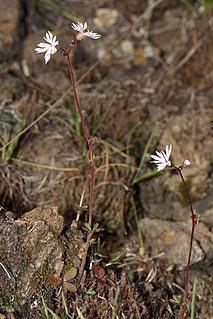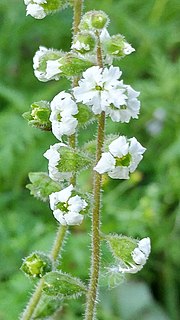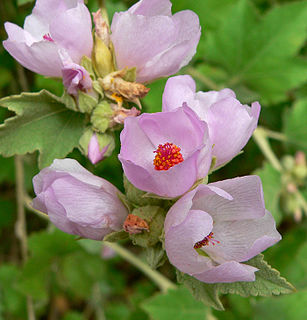
Eriophyllum lanatum, with the common names common woolly sunflower and Oregon sunshine, is a common, widespread, North American plant in the sunflower family.

Rubus leucodermis, also called whitebark raspberry, blackcap raspberry or blue raspberry, is a species of Rubus native to western North America, from Alaska south as far as California, Arizona, New Mexico, and Chihuahua.

Lithophragma is a genus of flowering plants containing about nine species native to western North America. These plants are known generally as woodland stars. The petals of the flowers are usually bright white with deep, long lobes or teeth. Each petal may look like three to five petals, when at closer inspection the lobes fuse into a single petal at its base. Most species reproduce via bulblets instead of seeds. L. maximum is a federally listed endangered species. Lithophragma specifically coevolved with moths of the genus Greya, who pollinate and only lay eggs on Lithophragma plants.

Chasmanthe floribunda is a species of flowering plants in the iris family which is known by the common name African flag. This plant is endemic to Cape Province in South Africa, but it has been introduced to other areas of similar climate, and is considered to be naturalized in California, Algeria, Australia, Argentina, and St. Helena.

Chaenactis douglasii is a North American species of flowering plant in the daisy family known by the common name Douglas' dustymaiden.

Chaenactis glabriuscula, with the common name Yellow pincushion, is a species of flowering plant in the daisy family. It is native to California and Baja California.

Trillium albidum, also known as giant white wakerobin, white toadshade, and sweet trillium, is a species of flowering plant in the family Melanthiaceae. The species is endemic to the western United States, ranging from west central California through Oregon to Washington. It is found in diverse habitats, on the moist slopes of mixed deciduous-coniferous forests, among shrubs and thickets, and along stream banks and river beds.

Lithophragma affine is a species of flowering plant in the saxifrage family known by the common name San Francisco woodland star. It is native to the coast of western North America from Oregon to Baja California, where it grows in open habitat on mountain slopes, hills, and canyonsides. It is a rhizomatous perennial herb growing erect or leaning with a tall naked flowering stem. The leaves are located on the lower part of the stem, each divided into sharp-pointed lobes. The stem bears up to 15 widely spaced flowers, each in a cuplike calyx of red or green sepals. The five petals are bright white, up to 1.3 centimeters long, and divided into three toothlike lobes at the tips.
Lithophragma bolanderi is a species of flowering plant in the saxifrage family known by the common name Bolander's woodland star. It is endemic to California, where it is known from several mountain ranges, including the North Coast Ranges, the foothills of the Sierra Nevada, and the San Gabriel Mountains. It grows in many types of open habitat. It is a rhizomatous perennial herb growing erect or leaning with a tall naked flowering stem. The leaves are located on the lower part of the stem, each divided into rounded lobes. The stem bears up to 25 flowers, each in a cuplike calyx of red or green sepals. The five petals are white, under one centimeter long, and toothed or smooth along the edges.

Lithophragma cymbalaria is a species of flowering plant in the saxifrage family known by the common name mission woodland star.

Lithophragma glabrum is a slender perennial western North American mountain plant in the Saxifrage family (Saxifragaceae), known by the common names bulbous woodland star, bulbiferous prairie-star, smooth woodland star, and smooth rockstar.

Lithophragma maximum, known by the common name San Clemente Island woodland star, is a rare species of flowering plant in the saxifrage family. It is endemic to San Clemente Island, one of the eight Channel Islands of California. It is known from only about four kilometers of rocky coastal cliffs on the edge of the island. The plant was thought to be extinct until a few specimens were rediscovered in 1979. Only 200 individuals were tallied in a 1996 survey. In 1997 the plant was listed as an endangered species on the federal level.

Lithophragma tenellum is a species of flowering plant in the saxifrage family known by the common name slender woodland star.

Malacothamnus fasciculatus, with the common name chaparral mallow, is a species of flowering plant in the mallow family. It is found in far western North America.

Ribes inerme is a species of currant known by the common names whitestem gooseberry and white stemmed gooseberry. It is native to western North America from British Columbia to California and westward to the Rocky Mountains. It grows in mountain forests, woodlands, and meadows.

Ribes velutinum is a species of currant known by the common name desert gooseberry.

Sidalcea oregana is a species of flowering plant in the mallow family known by the common name Oregon checkerbloom.

Silene douglasii is a species of flowering plant in the family Caryophyllaceae known by the common name Douglas's catchfly.

Trautvetteria is a genus of flowering plants in the buttercup family. Today it is often considered a monotypic genus, containing only one species, Trautvetteria caroliniensis, which is known by the common names Carolina bugbane, false bugbane, and tassel-rue. A second species, T. japonica, is now generally considered a variety of this species. The genus is named for the botanist Ernst Rudolf von Trautvetter.
Lithophragma trifoliatum is a variety of flowering plant in the saxifrage family known from the western slope of the Cascade Range and Sierra Nevada in California. It is sometimes considered its own species based on the pink, fragrant flowers, the shape of the hypanthium, and other characters. Others consider it to be a sterile variety of L. parviflorum that likely now persists by vegetative reproduction.


















